After the last pay-test we decided to make the game a bit more like history and a bit more like a real game. So this time with equal point army lists and instead of PzIV against the T34s, make it more challenging with PzIIIF’s.
So 1,200 points a side, look like this
Russians
4x squads of infantry total 304 pts
2x Plt, HQ 72 pts
1x Co HQ 72 pts
unit 2x T34/76 400 pts
2x tank rider squads 160 pts
2x HMG 120 pts
1x 82mm mortar 65 pts
Total 1193 points
Germans
3x squads Pz Grenadiers 588 pts
1x Plt HQ in SdKfz 251 122 pts
2x PzIIIF 464
Total 1174 points
Pic during game
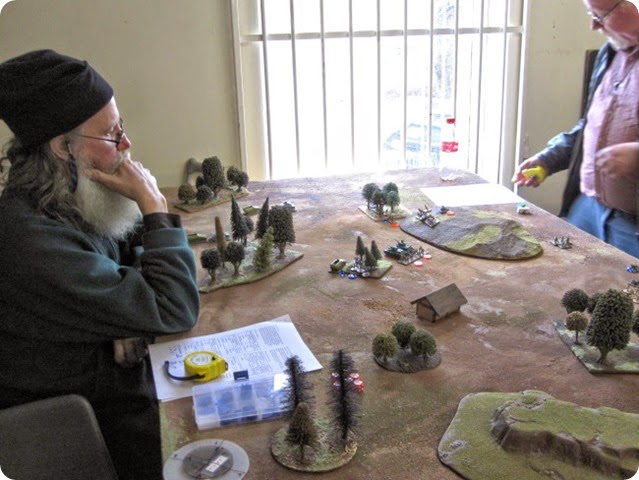
Russian squads organised into larger units on my advice (as author of the rules). Putting two squads and the platoon leader into one unit makes them less flexible but gives them a lot of punch and staying power.
Advantage to the Russians in terms of numbers and better tanks (the T34 has a frontal armour of 8 and a strength 6 gun with a range of 30, the PZIIIF has frontal armour of 3 and a strength 8 gun with a range of 20). The Germans had the advantage of superior fighting ability and morale, their infantry also being carried in APC.
Now after one of the previous play-tests a rule for automatic spotting at distance of 5 was introduced. That means that both sides units are spotted, if either sides unit is moved to within that distance of an enemy unit. As you will see, that became important in this game.
In summary, Action all Fronts is a WW2 one model = one man game, with IGoUGo and alternate unit activations. During an activation a unit (squad or tank usually) can make multiple actions the most important being to move, shoot or spot enemy targets. Nothing can be shot at until it is spotted. And the other thing is that the enemy can attempt an over-watch fire action with one of their units, if one of your spotted units moves or fires.
The Russians boldly advance their two T34s into the centre, covered by infantry on the hill to their right and with their own tank riders on the back of the T34s.
The Germans respond by bringing up a section of Panzer Grenadiers and dismounting in the wood to the left of the T34s.
But the Panzer Grenadiers are so close to the Russians that they are automatically spotted (see previously) and the Russian supporting mortars open up on overwatch fire and wipe the dismounted Germans out. The Germans now having spotted the T34’s bring out their own PzIII tanks to engage the T34s. A lucky shot with an HE round from one of the PzIII disables both T34s (as they are very close together and causes major losses on their tank riders. Meanwhile more Russian infantry are brought up to support the attack and the Germans occupy the woods in front of the Russians.
The German player then attempts to get behind one of the T34s and finish it off with a shot on the rear armour but fails and instead becomes vulnerable to the Russian infantry, who first advance and then charge the isolated PzIII.
As they advance the PzIII uses overwatch fire to shoot at the Russian infantry, both with HE from its 50mm gun and with its machine guns. The Russians take casualties but continue the attack.
The Russian infantry swarm over the Panzer and destroy it.
The game ended at this point, the German player saying that he had caused the Russians losses, he had been unable to stop them and now down to only one Panzer and two squads of Pz Grenadiers, he would be overrun. So rather than allow that to happen, he would withdraw and live to fight another day.
This was the first play-test game using artillery (mortars) and now all the players want mortars in their army. Certainly this was the first time that the Russians got their act together, choosing the right army order and keeping the attack going. Probably sending the T34’s out into the middle of the table early on in the game was a big mistake.





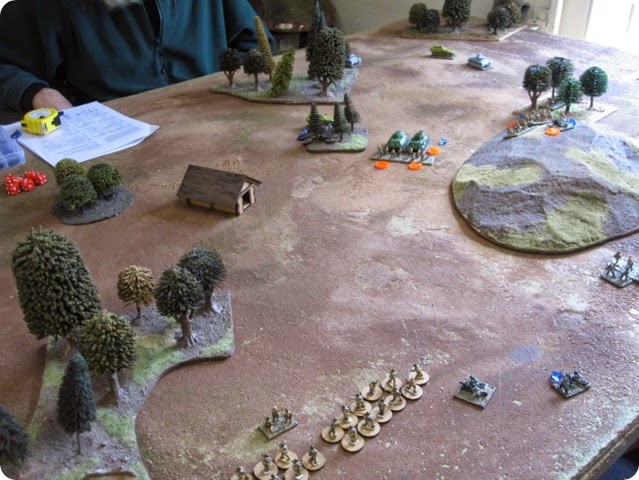
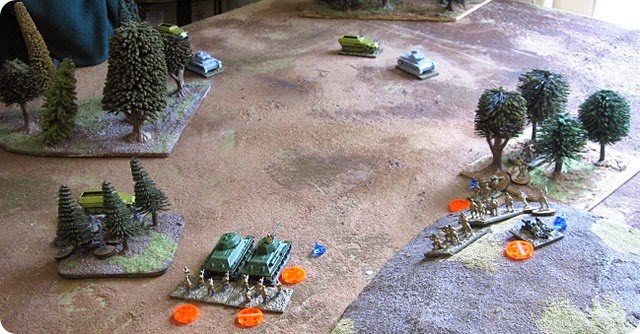
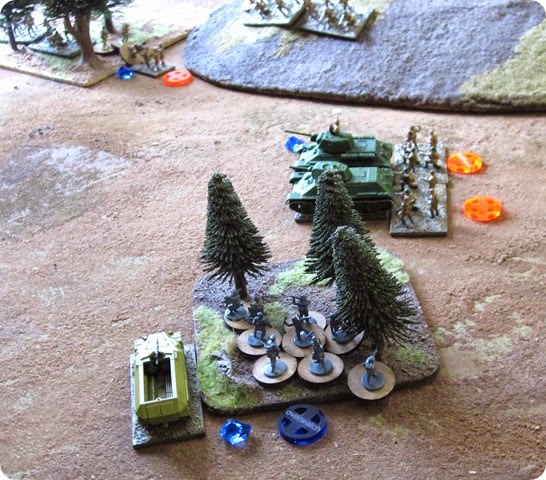

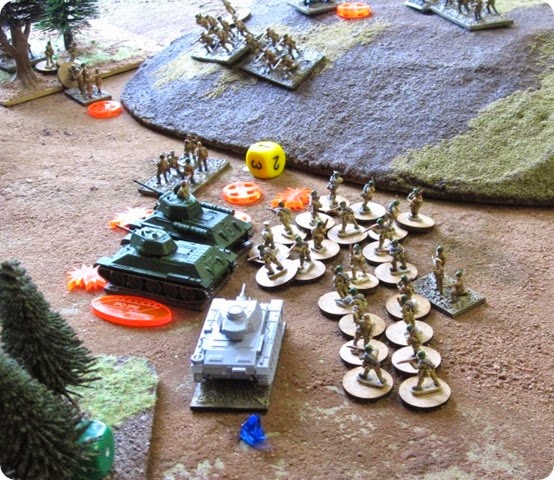
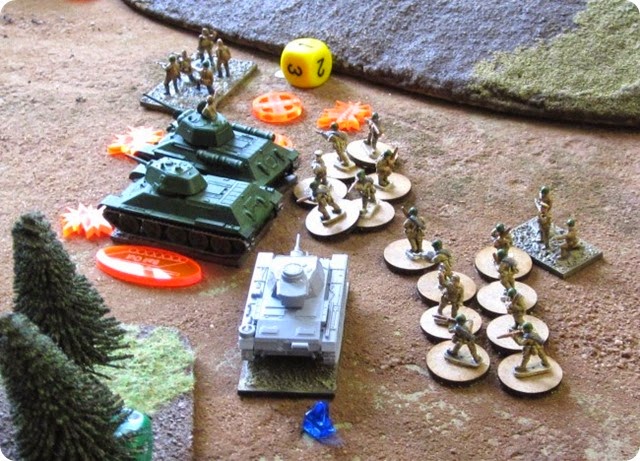
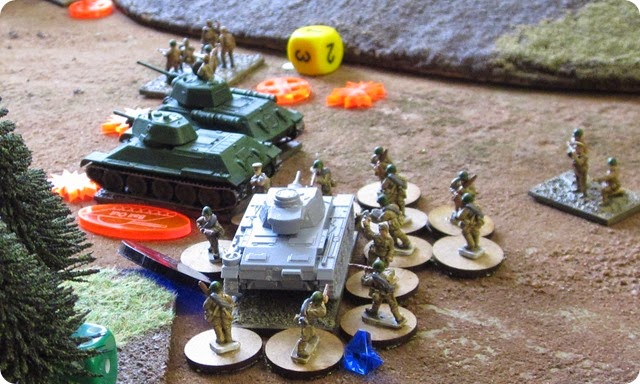
Good AAR :-)
ReplyDeleteJason.
T34/76 has a 76/L41.5 gun while the Pz IIIF has a 50L42 gun. So why is their AT value the same and how would a 2" diameter HE shell cripple two T34 at the same time? For that matter how did the Germans manage to fire between the Soviet tanks? 30 inch range for a 76 and 20 for a 50mm gun. 1 inch equals ~30m. 76 shoots ~900m, 50mm shoots 600m. Rifle range would be 10"or 300m, a panzerfaust 1" or 30m. Right?
ReplyDeleteAs you can see the German 50mm gun actually has a better AT value (8) compared to the Russian 76.2 (6). The reason, the penetration of the 76mm was not as good as the 50mm. The advantage of the 76mm was the longer range, as per the rules.
DeleteAs for the HE shot, imagine the HE round hitting one tank, blowing off its track and doing the same to the other (and of course wounding a lot of the tank riders). Tanks look to be 3 feet or so apart to me, certainly close enough for one tank rider to reach across and grab the hand of a rider on the other tank. Thats the penalty of jamming your tanks too close together.
I think you are confusing the German 50L42 on the F model with the 50L60 on the J-M models. Does your Pak 38 have an AT value of 8? Same gun. The 50L42 could barely stop a T34 using HVAP ammunition whereas the Russian 76mm would punch through a Pz III or IV.
ReplyDeleteHE vs the 2 T34 could clear the tank Riders but except for a direct hit probably not affect the tracks or suspension. A direct hit by HE by a round under 75mm doesn't have much explosive and the fragments won't affect the tracks. Same for HE versus buildings made from stone or concrete. You need a big shell.
Mortars. How did the Soviet tanks and tank Riders notify the mortar crew the spotted German infantry close by? Tank radios were rare in the Soviet Army in 1941-43. They would also be on a different frequency and a Soviet mortar crew wouldn't have a radio. A battery wouldn't. Mortar fire was over open sights - the mortar battery could see the target area- or controlled by an observer using a field telephone.
There was not much difference between the armour penetration of the 50L42 or 50L60, so they are both treated the same. Certainly a Pz III would have a harsd time stopping a T34 frontally which is probably why HE was used instead of AP, and it worked very well.
DeleteTry this comment on the T34 tracks,
"The deficiencies in our tracks from their viewpoint results from the lightness of their construction. They can easily be damaged by small calibre shells and mortar bombs. The pins are extremely poorly tempered and made of poor steel. As a result they quickly wear and the track often breaks."
https://forums.armchairgeneral.com/forum/world-history-group-hosting/rkka-the-russian-army-in-world-war-ii/47475-evaluation-of-t-34-kv-1-by-aberdeen
Have a look at the 6th picture down. Mortars on the top of the hill, Russian infantry at the bottom. Fire on open sights, tree line in front of the infantry.
You have it, most Russian tanks did not have a radio, hence the Lack of Radios rules on p.50
Oh and you are right frontal armour of a PzIII is only 3 and that of an early PzIV only 3 as well. So a Russian 76.2mm gun has a good chance (33%) of achieving a kill frontally, even at over half range. At half range or less its a 50% chance.
DeleteIn contrast the early T34 has a frontal armour of 8. They are about the same in points value with the T34 faster but the PzIII has higher fighting skill and better morale (which the Russian player can compensate for with the Stick to the Plan rule on p.50).